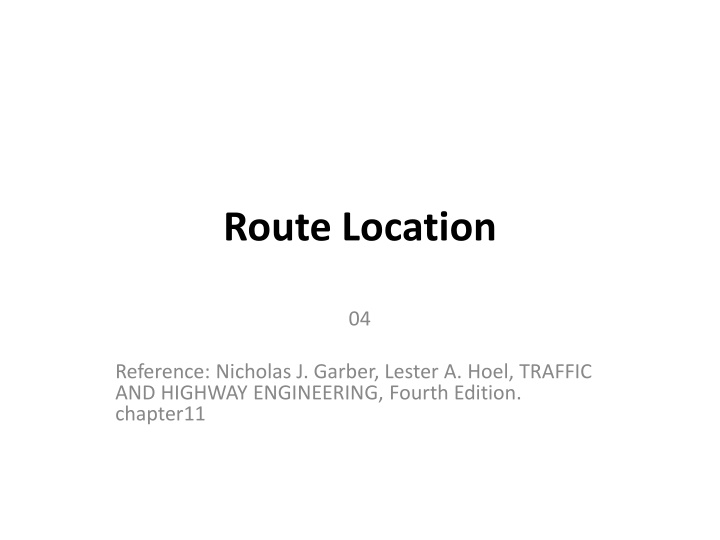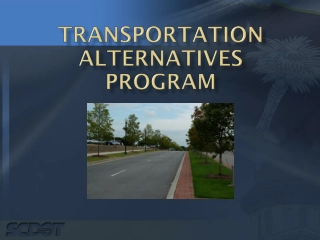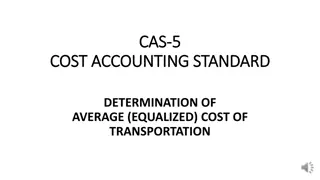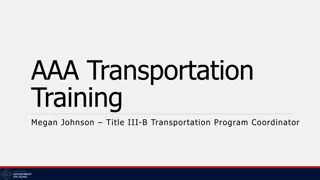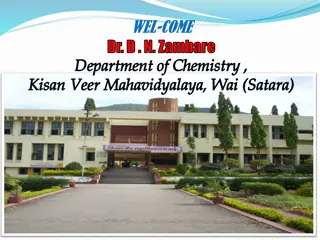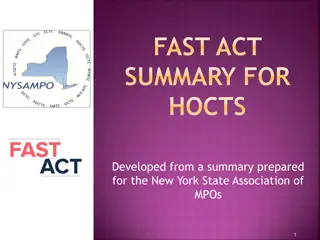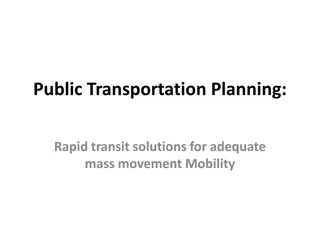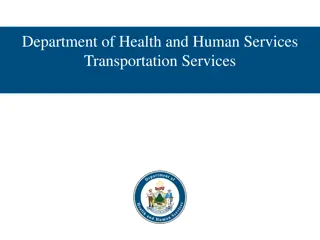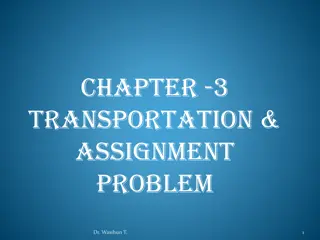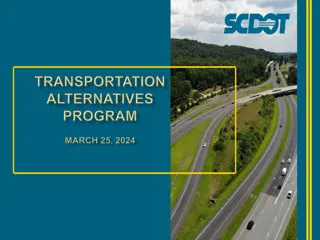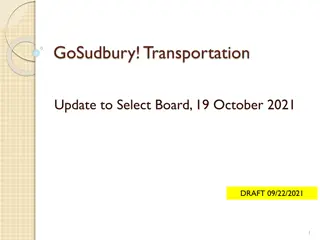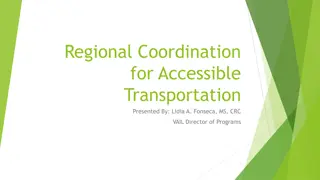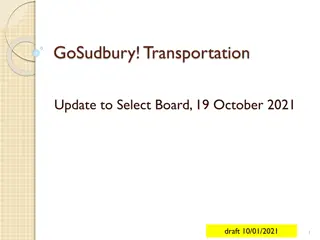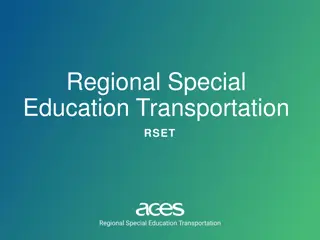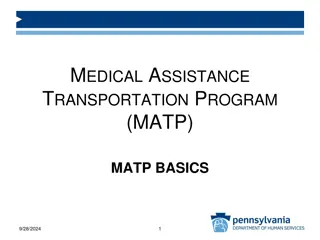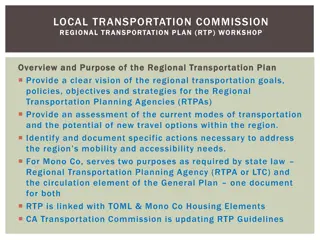Basic Elements of Transportation Planning
The transportation planning process involves seven key elements including situation definition, problem definition, search for solutions, analysis of performance, evaluation of alternatives, choice of project, and specification and construction. Each phase is crucial for understanding the current situation, defining the problem, exploring solutions, and evaluating performance to make informed decisions.
Download Presentation

Please find below an Image/Link to download the presentation.
The content on the website is provided AS IS for your information and personal use only. It may not be sold, licensed, or shared on other websites without obtaining consent from the author.If you encounter any issues during the download, it is possible that the publisher has removed the file from their server.
You are allowed to download the files provided on this website for personal or commercial use, subject to the condition that they are used lawfully. All files are the property of their respective owners.
The content on the website is provided AS IS for your information and personal use only. It may not be sold, licensed, or shared on other websites without obtaining consent from the author.
E N D
Presentation Transcript
Route Location 04 Reference: Nicholas J. Garber, Lester A. Hoel, TRAFFIC AND HIGHWAY ENGINEERING, Fourth Edition. chapter11
BASIC ELEMENTS OF TRANSPORTATION PLANNING The transportation planning process comprises seven basic elements, which are interrelated and not necessarily carried out sequentially. The information acquired in one phase of the process may be helpful in some earlier or later phase, so there is a continuity of effort that should eventually result in a decision. The elements in the process are: Situation definition Problem definition Search for solutions Analysis of performance Evaluation of alternatives Choice of project Specification and construction
Situation Definition The first step in the planning process is situation definition, which involves all of the activities required to understand the situation that gave rise to the perceived need for a transportation improvement. In this phase, the basic factors that created the present situation are described, and the scope of the system to be studied is delineated. The present system is analyzed and its characteristics are described. Information about the surrounding area, its people, and their travel habits may be obtained. Previous reports and studies that may be relevant to the present situation are reviewed and summarized. Both the scope of the study and the domain of the system to be investigated are delineated.
Problem Definition The purpose of this step is to describe the problem in terms of the objectives to be accomplished by the project and to translate those objectives into criteria that can be quantified. Objectives are statements of purpose, such as to reduce traffic congestion; to improve safety; to maximize net highway-user benefits; and to reduce noise. Criteria are the measures of effectiveness that can be used to quantify the extent to which a proposed transportation project will achieve the stated objectives. For example, the objective to reduce traffic congestion might use travel time as the measure of effectiveness. The characteristics of an acceptable system should be identified, and specific limitations and requirements should be noted. Also, any pertinent standards and restrictions that the proposed transportation project must conform to should be understood.
Search for Solutions In this phase of the planning process, consideration is given to a variety of ideas, designs, locations, and system configurations that might provide solutions to the problem. This is the brainstorming stage, in which many options may be proposed for later testing and evaluation. Alternatives can be proposed by any group or organization.
Analysis of Performance The purpose of performance analysis is to estimate how each of the proposed alternatives would perform under present and future conditions. The criteria identified in the previous steps are calculated for each transportation option. Included in this step is a determination of the investment cost of building the transportation project, as well as annual costs for maintenance and operation. This element also involves the use of mathematical models for estimating travel demand. The number of persons or vehicles that will use the system is determined, and these results, expressed in vehicles or persons/hour, serve as the basis for project design. Other information about the use of the system (such as trip length, travel by time of day, and vehicle occupancy) are also determined and used in calculating user benefits for various criteria or measures of effectiveness. Environmental effects of the transportation project (such as noise and air pollution levels and acres of land required) are estimated. These nonuser impacts are calculated in situations where the transportation project could have significant impacts on the community or as required by law.
Evaluation of Alternatives The purpose of the evaluation phase is to determine how well each alternative will achieve the objectives of the project as defined by the criteria. The performance data produced in the analysis phase are used to compute the benefits and costs that will result if the project is selected. In cases where the results cannot be reduced to a single monetary value, a weighted ranking for each alternative might be produced and compared with other proposed projects. For those effects that can be described in monetary terms, the benefit cost ratio (described in Chapter 13) for each project is calculated to show the extent to which the project would be a sound investment. Other economic tests might also be applied, including the net present worth of benefits and costs. In situations where there are many criteria, particularly in an environmental analysis, the results can be shown in a cost-effectiveness matrix (for example, project cost versus number of homes displaced) that will furnish a better understanding as to how each alternative performs for each of the criteria and at what cost. The results can be plotted to provide a visual comparison of each alternative and its performance.
Choice of Project Project selection is made after considering all the factors involved. In a simple situation, for example, where the project has been authorized and is in the design phase, a single criterion (such as cost) might be used and the chosen project would be the one with the lowest cost. With a more complex project, however, many factors have to be considered, and selection is based on how the results are perceived by those involved in decision-making. If the project involves the community, it may be necessary to hold additional public hearings. A bond issue or referendum may be required. It is possible that none of the alternatives will meet the criteria or standards, and additional investigations will be necessary. The transportation engineer, who participates in the planning process, may have developed a strong opinion as to which alternative to select. Such bias could result in the early elimination of promising alternatives or the presentation to decision-makers of inferior projects. If the engineer is acting professionally and ethically, he or she will perform the task such that the appropriate information is provided to make an informed choice and that every feasible alternative has been considered.
Specification and Construction Once the transportation project has been selected, the project moves into a detailed design phase in which each of the components of the facility is specified. For a transportation facility, this involves its physical location, geometric dimensions, and structural configuration. Design plans are produced that can be used by contractors to estimate the cost of building the project. When a construction firm is selected, these plans will be the basis on which the project will be built.
Environmental Impact Statements Federal and/or state regulations may require that the environmental impacts of proposed projects be assessed. These impacts may include effects on air quality, noise levels, water quality, wetlands, and the preservation of historic sites of interest. The analytical process through which these effects are identified can take one of three forms, depending on the scope of the proposed project: a full environmental impact statement (EIS), a simpler environmental assessment (EA), or a cursory checklist of requirements known as a categorical exclusion (CE). Examples of projects that might receive the CE designation are utility installations along an existing transportation facility, bicycle lanes, noise barriers, and improvements to rest areas: Generally, projects that receive the CE designation do not require further detailed analysis. Projects for which an EIS is required might include the construction of a new limited-access freeway or a fixed guideway transit line. For some projects, it might not initially be clear whether the project merits a full environmental study. For those projects, an environmental assessment may be conducted, and the EA will either result in a finding of no significant impact (FONSI) or in a finding that a full EIS is warranted. For some large-scale projects that require an EIS, projects may be tiered. The first tier addresses macroscopic issues, such as whether a proposed facility should be a highway bypass or a light rail line and whether it should follow an eastern or western alignment. The second tier addresses microscopic issues, such as the number of parcels that might be taken once a decision has been made that the facility will be a rail line following a western alignment. The purpose of this environmental review process is to assure that all potential effects (positive as well as adverse) are addressed in a complete manner so that decision-makers can understand the consequences of the proposed project. Once an agency, such as a state department of transportation, completes a draft EIS, the public is given an opportunity to comment. The project cannot proceed until the revised, final EIS has been accepted by the appropriate federal and state regulatory agencies. Generally, these federal regulatory agencies will include FHWA and FTA.
Elements of an EIS Although the entire environmental review process is beyond the scope of this text, examination of some of the common elements of an EIS illustrate its role in transportation planning. The project s purpose and need section articulates why the project is being undertaken: Is it to improve safety, to increase capacity in response to expected future traffic growth, or is it a deficient link in a region s comprehensive transportation network? The purpose and need section should include relevant AADT projections, crash rates, and a description of existing geometric conditions. The alternatives to the proposed project, such as the do-nothing case, should be described, as well as any criteria that have been used to eliminate alternatives from further consideration. For example, if a second bridge crossing over a body of water is being considered, then alternatives could be to change the location, to widen an existing bridge, to improve ferry service, or to do nothing. Criteria that prevent further consideration, such as the presence of an endangered species at what would have been another potential location or the permanent loss of several acres of wetlands, are given in this section. The environmental effects of the proposed project, such as water quality (during construction and once construction is complete), soil, wetlands, and impacts on plant and animal life, especially endangered species, should be analyzed. Note that environmental effects also include the impact on communities, such as air quality, land use, cultural resources, and noise.
Computing Environmental Impacts for Emissions and Noise The level of detail in a full EIS can be staggering given the amount of analysis required to answer some seemingly simple questions: What is the noise level? How much will automobile emissions increase? A number of tools are provided by regulatory agencies that can answer some of these questions. For example, the Environmental Protection Agency (EPA) has developed an emissions-based model (known as MOBILE) that may be used to evaluate emissions impacts of alternatives. The results of this model, compared with observed carbon monoxide concentrations, can be used to determine the relative impact of different project alternatives on the level of carbon monoxide.
